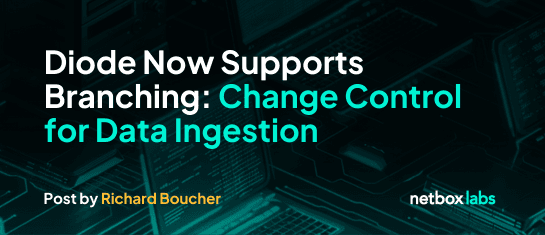Diode Now Supports Branching: Change Control for Data Ingestion

Here’s a scenario most NetBox users will recognize: you’ve set up automated discovery to keep your NetBox data current. Maybe it’s pulling inventory from your network devices, syncing configuration management data, or ingesting information from monitoring systems. It’s working great, automatically updating NetBox with the latest state of your infrastructure.
Until one day something unexpected shows up in your data. A misconfigured device reports incorrect information. A discovery script has a bug. An upstream system sends bad data. And now that questionable information is sitting in your production NetBox database, potentially feeding into automation pipelines, configuration generators, or compliance reports.
We’ve heard from Diode users who want their automated ingestion workflows to respect the same change management practices they use for manual updates. Today we’re making it possible for Diode users to stage ingested changes in NetBox branches for review, before they are merged to main.
Diode is NetBox’s purpose-built data ingestion service that simplifies how network data flows into your NetBox deployment. It handles the complexity of NetBox’s data model, automatically creating related objects and resolving dependencies so you can send data in intuitive blocks rather than carefully orchestrated API calls. If you’re new to Diode, check out our introduction to Diode to see how it streamlines data ingestion. For existing Diode users, today’s release adds something you’ve been asking for: branch support.
Review Your Data Before It Goes Live
With this update, Diode can now reconcile ingested data against any branch you configure, not just main. Your automated discovery jobs, SDK integrations, and data pipelines can all target a staging branch. The data lands there first, your team reviews what’s changed, and you merge to production only when everything checks out.
This is the same workflow you’d use for manual changes in NetBox Branching, now extended to your automated data ingestion. Discovery finds 50 new devices? They appear in your staging branch. You validate they’re correct, check that attributes look right, and merge. Configuration management system reports a site rename? It hits staging first. You confirm it’s intentional, approve the change, and push it live.
How Your Workflow Changes
The technical implementation is straightforward. Simply update your Diode server and NetBox plugin to the latest versions (v1.8.0+ and v1.5.0+, respectively), configure the NetBox plugin settings with which branch should receive ingested data, and Diode handles the routing. Your existing scripts, SDK calls, and discovery agents don’t need changes. They keep sending data to Diode, but now that data lands in your chosen branch instead of going straight to production.
When Diode processes incoming data, it retrieves your configured staging branch and runs all the reconciliation logic against that branch. Objects are matched, changes are detected, conflicts are handled, all within that isolated workspace. Your main branch stays untouched until you’re ready to merge.
Common Patterns This Enables
Discovery with guardrails. Run NetBox Discovery (Orb Agent) continuously to keep your inventory current, but route everything through a staging branch. Quick daily reviews catch issues before they propagate. For high-risk changes, your team can examine them closely before approving.
Safe integration testing. Building a new Diode integration or modifying an existing one? Point it at a test branch while you work out the kinks. Iterate freely without worrying about corrupting your production data model. When you’re confident it works correctly, switch it to your staging branch for normal review, or point it directly at main if no review is needed.
Compliance and audit trails. Some organizations require approval for all network data changes, even automated ones. Stage before merge gives you a clear checkpoint where changes wait for sign-off. The merge becomes your approval action, and NetBox’s change logging captures who approved what and when.
Multi-source validation. If you’re ingesting data from several systems, you might want to validate consistency before updates go live. Stage everything in a branch, review how data from different sources interacts, resolve any conflicts or inconsistencies, then merge the validated result.
What This Means for Your Team
If you’ve been hesitant to fully automate your NetBox updates because you wanted human oversight, this removes that barrier. You get the efficiency of automated ingestion with the safety of manual review. Your automation runs continuously, but changes flow through whatever approval process your organization needs.
For teams already running Diode with manual branching workflows, this closes the gap between how you handle manual changes and automated ones. Everything flows through the same branch structure, the same review process, the same merge operations.
Where This Goes Next
This release establishes the foundation for branch-aware ingestion. We’re watching how teams integrate this into their change management workflows and exploring what additional capabilities would be valuable. Automated validation rules before merge? Integration points with external approval systems? Branch lifecycle policies for ingested data? Your feedback shapes the roadmap.
If you’re using stage before merge in your environment, we want to hear about it. What workflows does it enable for your team? What rough edges are you running into? Where would you like to see this capability go next? Join the conversation in the #orb channel of the NetDev Community Slack.
The updated components, installation instructions and technical details are available now on the Diode GitHub repository.
